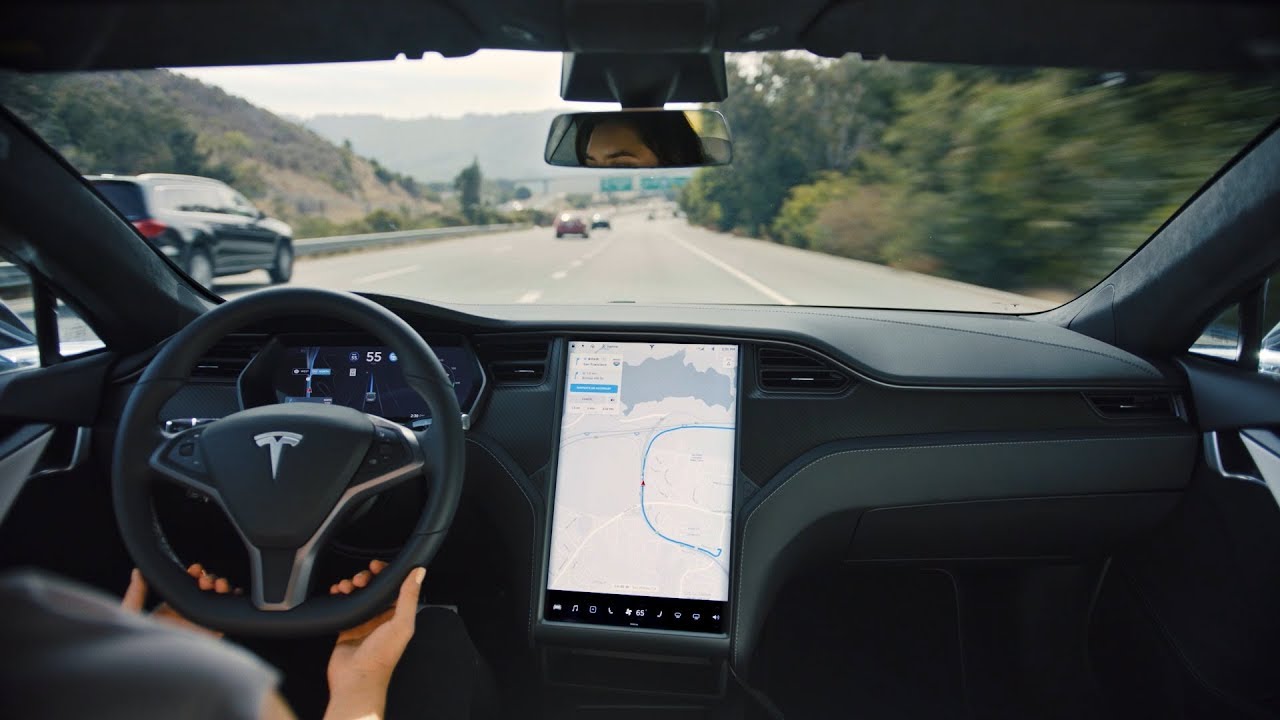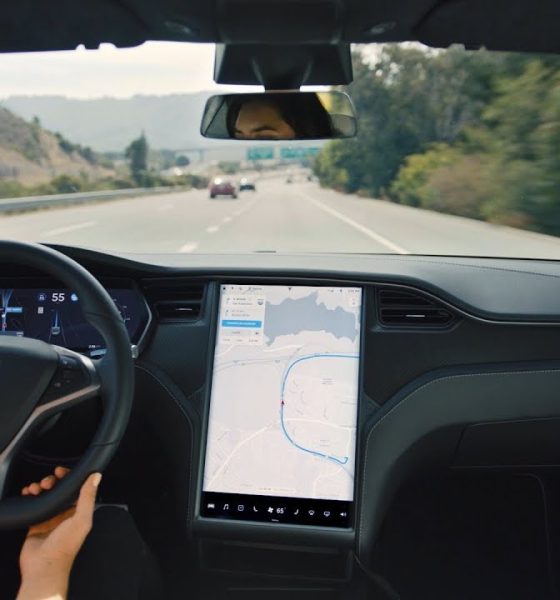A Tesla owner recently critiqued the performance of Autopilot and Full Self-Driving after the conclusion of a 6,400-mile trip across the United States. According to the driver, more than 99 percent of the trip was driven utilizing Tesla’s semi-autonomous driving functions, with the critiques showing the automaker’s strengths and weaknesses in terms of how both Autopilot and FSD can affect a drive of this substantial distance.
Tim Heckman took his Model S Plaid equipped with FSD Beta and Tesla Vision on the 6,392-mile trip from Los Angeles to Reading, Pennsylvania, and back, recording most of the (currently unreleased) footage on a GoPro mounted inside the vehicle. There were undoubtedly positives but also negatives, as Heckman describes the utilization of Autopilot and FSD on a trip of this length as an advantage in the “personal cost” of driving this many miles in a matter of two weeks.
On December 15th I left to drive from Los Angeles to near Philadelphia. Got back yesterday, after a total of 6,392 miles in the Model S Plaid with #FSDBeta.
Drove more than 99% autonomously, and I’ve some not great @Tesla Autopilot + FSD thoughts and experiences to share… ?
— Tim Heckman (@theckman) January 1, 2023
But where Tesla’s systems helped, it hurt elsewhere. Heckman describes frustration with the company’s recent transition to a camera-only approach, known as Tesla Vision, the suite’s lack of consistency outside of California, and where the company might have spent its focus over the past few years during the development.
No Radar, No Problem?
As Heckman took the drive in a Model S Plaid with camera-based Tesla Vision, the lack of radar was the first point of emphasis. Autopilot was more accurate and less stressful in a previous Tesla that equipped both cameras and radar for operation, Heckman said. “The removal of radar on the highway was a huge mistake,” he said in a Tweet. “Tesla Vision very often misidentified vehicles in front as being much closer than they are, trigging strong phantom braking. Sometimes losing 20mph of speed before I can react, which is a huge safety concern.”
During some points of the drive, the vehicle would recognize cars and adjust speeds that were not actually there. Additionally, Tesla Vision’s performance in low-visibility conditions like rain and fog was not ideal. Past iterations of the suites proved more effective, in Heckman’s opinion.
The automaker rolled out Tesla Vision in early 2021 in the Model 3 and Model Y, and the Model S and Model X received the update in 2022. When Tesla announced it would transition to a camera-only system, CEO Elon Musk explained that radar had helped solve the shortfalls that cameras couldn’t solve. However, it was never in the plan to rely on both radar and cameras.
“And when your vision works, it works better than the best human because it’s like having eight cameras, it’s like having eyes in the back of your head, beside[s] your head and has three eyes of different focal distances looking forward. This is — and processing it at a speed that is superhuman. There’s no question in my mind that with a pure vision solution, we can make a car that is dramatically safer than the average person,” Musk said during the Q1 2021 Earnings Call.
Speed Limit Changes
Another huge problem Heckman described was a slow decrease in speed after the reduction of speed limits in an area. This occurred on streets and not on the highway, but still raised some concern. Heckman noted it took “many seconds” to reach the legal speed when limits decreased by as much as 20 MPH.
In fact, someone I know was pulled over on New Years Eve (yesterday) by a Nevada state trooper because #FSD took too long to slow down in observance of the speed limit going from 55mph to 35mph.
Is that acceptable? Especially when we’ll have single stack on the highway?
— Tim Heckman (@theckman) January 1, 2023
Were Autopilot and FSD beneficial during this trip?
Yes.
“I love long road trips, and Autopilot makes them easier,” Heckman said. Despite the issues, it was still a pleasant experience and something he hopes to do again on his next trek from LA to PA.
At the end of the day, I think this stuff has tremendous potential. But at this point there needs to be focus and good execution, while not causing regressions in the experience especially on features that impact your safety and the safety of others on the road.
— Tim Heckman (@theckman) January 1, 2023
Heckman said he believes the lack of progress and improvements when speaking in terms of highway performance may be related to Tesla’s focus on solving self-driving on city streets.
“As a result of changing focus, Autopilot experience is worse than when we got our Model 3 in summer 2019,” he said.
Fun Fact: Tim told me his two longest days of driving were from Fort Worth, TX, to Burbank, CA, equating to roughly 1,404 miles, and from Burbank, CA, to Amarillo, TX, for 1,079 miles.
I’d love to hear from you! If you have any comments, concerns, or questions, please email me at joey@teslarati.com. You can also reach me on Twitter @KlenderJoey, or if you have news tips, you can email us at tips@teslarati.com.

Elon Musk
Elon Musk proposes Grok 5 vs world’s best League of Legends team match
Musk’s proposal has received positive reception from professional players and Riot Games alike.
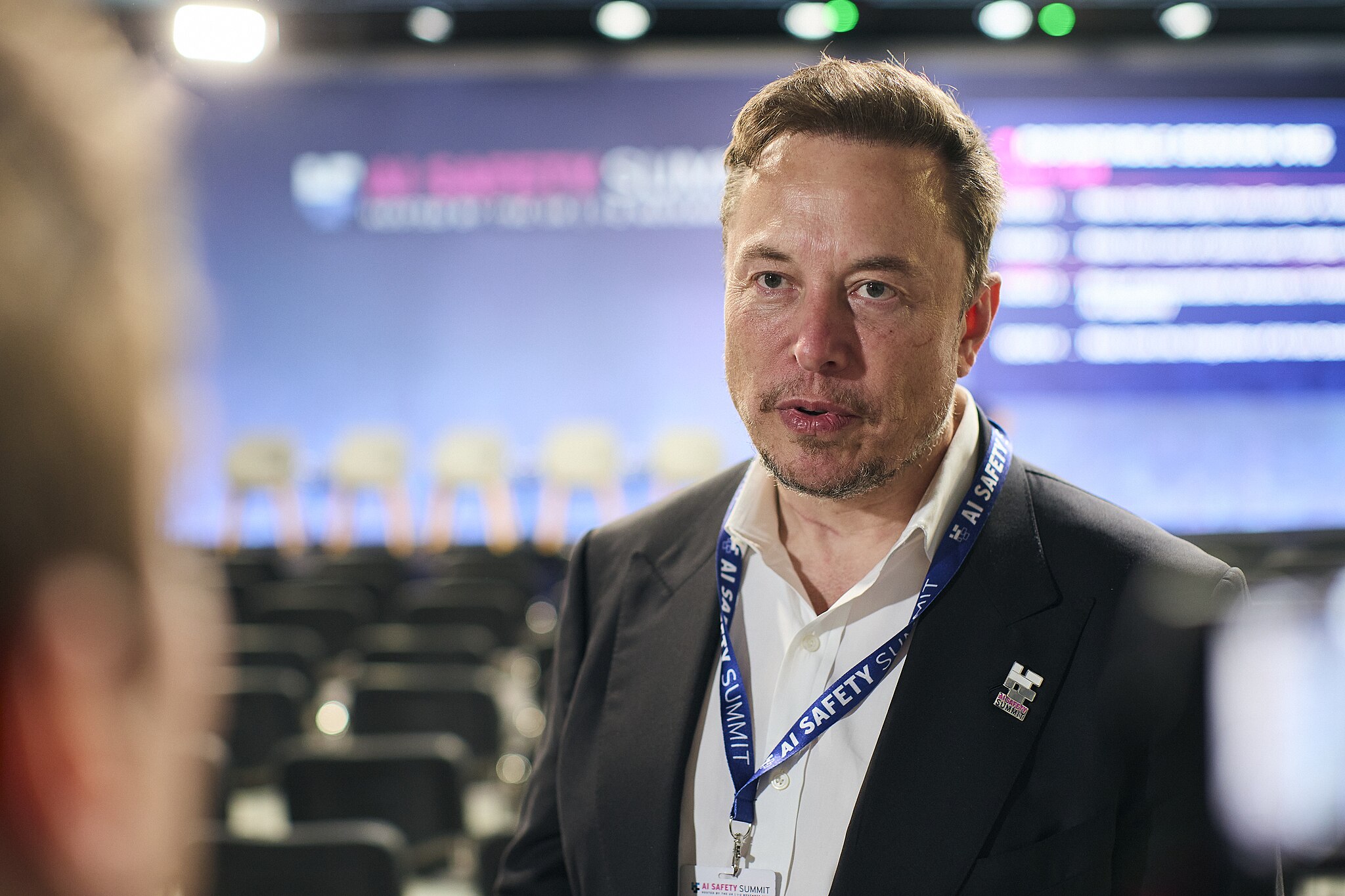
Elon Musk has proposed a high-profile gaming challenge for xAI’s upcoming Grok 5. As per Musk, it would be interesting to see if the large language model could beat the world’ best human League of Legends team with specific constraints.
Musk’s proposal has received positive reception from professional players and Riot Games alike, suggesting that the exciting exhibition match might indeed happen.
Musk outlines restrictions for Grok
In his post on X, Musk detailed constraints to keep the match competitive, including limiting Grok to human-level reaction times, human-speed clicking, and viewing the game only through a camera feed with standard 20/20 vision. The idea quickly circulated across the esports community, drawing commentary from former pros and AI researchers, as noted in a Dexerto report.
Former League pro Eugene “Pobelter” Park expressed enthusiasm, offering to help Musk’s team and noting the unique comparison to past AI-versus-human breakthroughs, such as OpenAI’s Dota 2 bots. AI researcher Oriol Vinyals, who previously reached Grandmaster rank in StarCraft, suggested testing Grok in RTS gameplay as well.
Musk welcomed the idea, even responding positively to Vinyals’ comment that it would be nice to see Optimus operate the mouse and keyboard.
Pros debate Grok’s chances, T1 and Riot show interest
Reactions weren’t universally optimistic. Former professional mid-laner Joedat “Voyboy” Esfahani argued that even with Grok’s rapid learning capabilities, League of Legends requires deep synergy, game-state interpretation, and team coordination that may be difficult for AI to master at top competitive levels. Yiliang “Doublelift” Peng was similarly skeptical, publicly stating he doubted Grok could beat T1, or even himself, and jokingly promised to shave his head if Grok managed to win.
T1, however, embraced the proposal, responding with a GIF of Faker and the message “We are ready,” signaling their willingness to participate. Riot Games itself also reacted, with co-founder Marc Merrill replying to Musk with “let’s discuss.” Needless to say, it appears that Riot Games in onboard with the idea.
Though no match has been confirmed, interest from players, teams, and Riot suggests the concept could materialize into a landmark AI-versus-human matchup, potentially becoming one of the most viewed League of Legends events in history. The fact that Grok 5 will be constrained to human limits would definitely add an interesting dimension to the matchup, as it could truly demonstrate how human-like the large language model could be like in real-time scenarios.
Tesla has passed a key milestone, and it was one that CEO Elon Musk initially mentioned more than nine years ago when he published Master Plan, Part Deux.
As per Tesla China in a post on its official Weibo account, the company’s Autopilot system has accumulated over 10 billion kilometers of real-world driving experience.
Tesla China’s subtle, but huge announcement
In its Weibo post, Tesla China announced that the company’s Autopilot system has accumulated 10 billion kilometers of driving experience. “In this respect, Tesla vehicles equipped with Autopilot technology can be considered to have the world’s most experienced and seasoned driver.”
Tesla AI’s handle on Weibo also highlighted a key advantage of the company’s self-driving system. “It will never drive under the influence of alcohol, be distracted, or be fatigued,” the team wrote. “We believe that advancements in Autopilot technology will save more lives.”
Tesla China did not clarify exactly what it meant by “Autopilot” in its Weibo post, though the company’s intense focus on FSD over the past years suggests that the term includes miles that were driven by FSD (Beta) and Full Self-Driving (Supervised). Either way, 10 billion cumulative miles of real-world data is something that few, if any, competitors could compete with.
Advertisement
–>
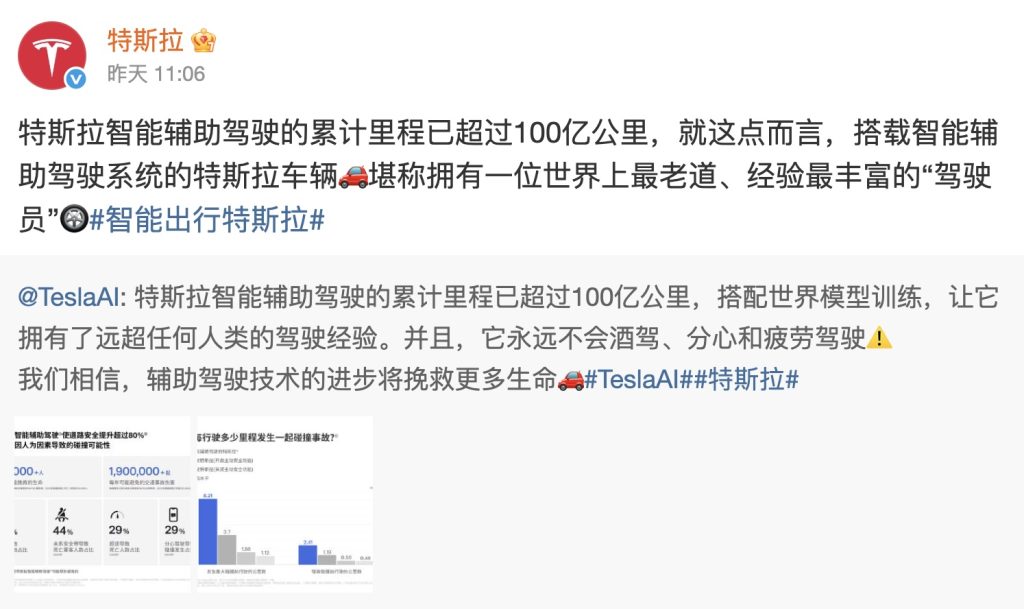
Elon Musk’s 10-billion-km estimate, way back in 2016
When Elon Musk published Master Plan Part Deux, he outlined his vision for the company’s autonomous driving system. At the time, Autopilot was still very new, though Musk was already envisioning how the system could get regulatory approval worldwide. He estimated that worldwide regulatory approval will probably require around 10 billion miles of real-world driving data, which was an impossible-sounding amount at the time.
“Even once the software is highly refined and far better than the average human driver, there will still be a significant time gap, varying widely by jurisdiction, before true self-driving is approved by regulators. We expect that worldwide regulatory approval will require something on the order of 6 billion miles (10 billion km). Current fleet learning is happening at just over 3 million miles (5 million km) per day,” Musk wrote.
It’s quite interesting but Tesla is indeed getting regulatory approval for FSD (Supervised) at a steady pace today, at a time when 10 billion miles of data has been achieved. The system has been active in the United States and has since been rolled out to other countries such as Australia, New Zealand, China, and, more recently, South Korea. Expectations are high that Tesla could secure FSD approval in Europe sometime next year as well.
News
Elon Musk’s Boring Company reveals Prufrock TBM’s most disruptive feature
As it turns out, the tunneling startup, similar to other Elon Musk-backed ventures, is also dead serious about pursuing reusability.
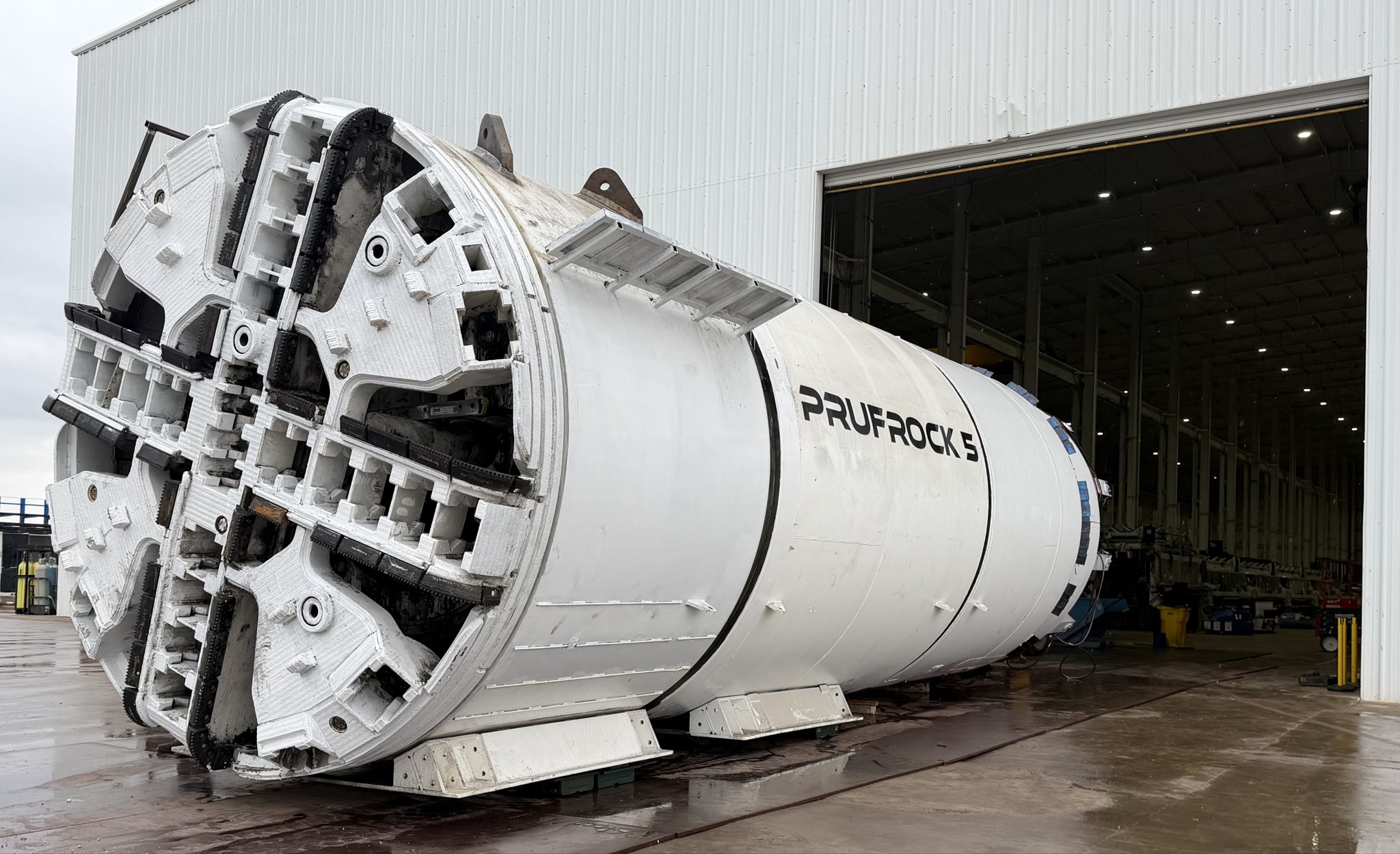
The Boring Company has quietly revealed one of its tunnel boring machines’ (TBMs) most underrated feature. As it turns out, the tunneling startup, similar to other Elon Musk-backed ventures, is also dead serious about pursuing reusability.
Prufrock 5 leaves the factory
The Boring Company is arguably the quietest venture currently backed by Elon Musk, inspiring far fewer headlines than his other, more high-profile companies such as Tesla, SpaceX, and xAI. Still, the Boring Company’s mission is ambitious, as it is a company designed to solve the problem of congestion in cities.
To accomplish this, the Boring Company would need to develop tunnel boring machines that could dig incredibly quickly. To this end, the startup has designed Prufrock, an all-electric TBM that’s designed to eventually be fast enough as an everyday garden snail. Among TBMs, such a speed would be revolutionary.
The startup has taken a step towards this recently, when The Boring Company posted a photo of Prufrock-5 coming out of its Bastrop, Texas facility. “On a rainy day in Bastrop, Prufrock-5 has left the factory. Will begin tunneling by December 1. Hoping for a step function increase in speed,” the Boring Company wrote.
Prufrock’s quiet disruption
Interestingly enough, the Boring Company also mentioned a key feature of its Prufrock machines that makes them significantly more sustainable and reusable than conventional TBMs. As per a user on X, standard tunnel boring machines are often left underground at the conclusion of a project because retrieving them is usually more expensive and impractical than abandoning them in the location.
As per the Boring Company, however, this is not the case for its Prufrock machines, as they are retrieved, upgraded, and deployed again with improvements. “All Prufrocks are reused, usually with upgrades between launches. Prufrock-1 has now dug six tunnels,” the Boring Company wrote in its reply on X.
The Boring Company’s reply is quite exciting as it suggests that the TBMs from the tunneling startup could eventually be as reusable as SpaceX’s boosters. This is on brand for an Elon Musk-backed venture, of course, though the Boring Company’s disruption is a bit more underground.
News
Tesla accused of infringing robotics patents in new lawsuit
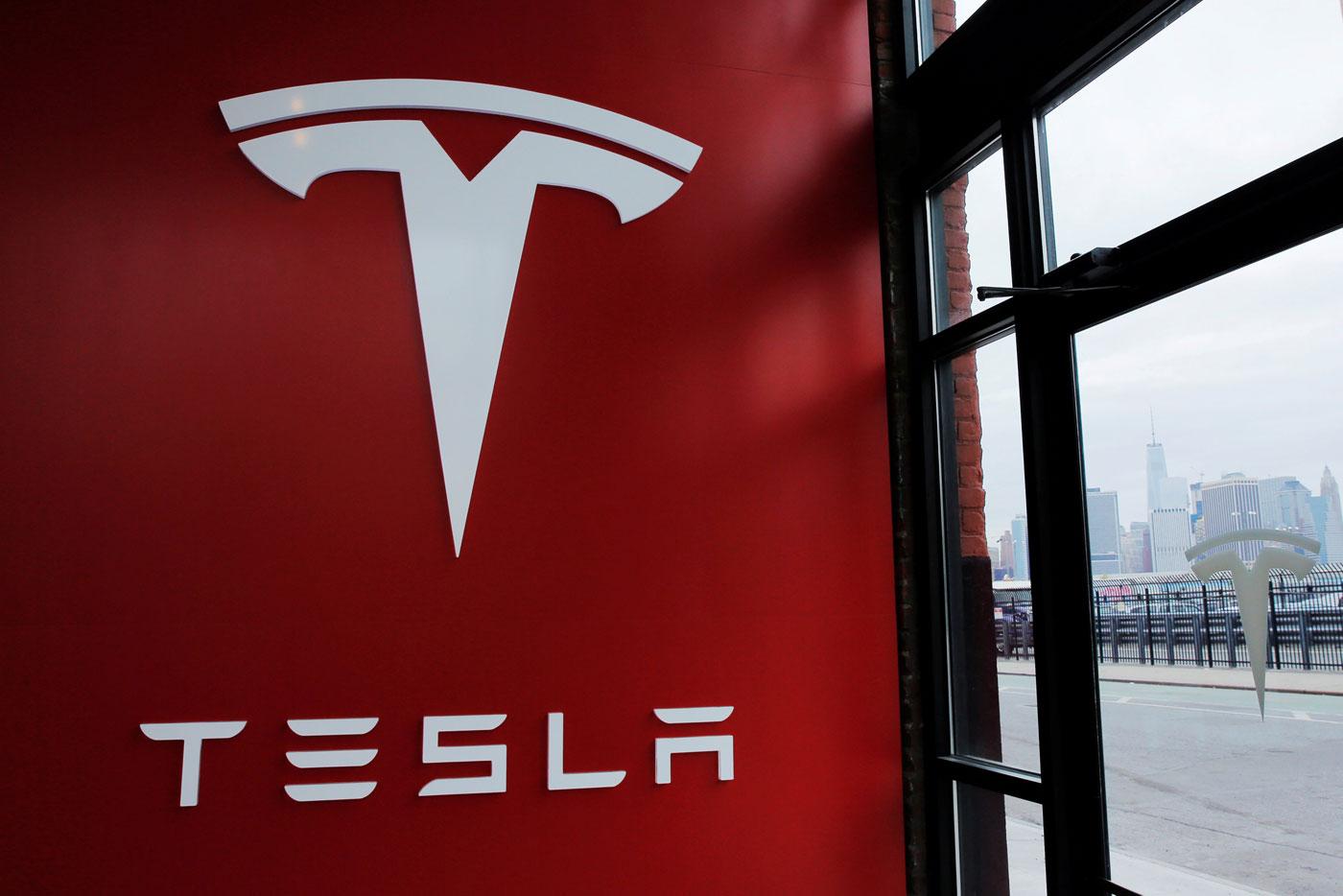
Tesla is being accused of infringing robotics patents by a company called Perrone Robotics, which is based out of Charlottesville, Virginia.
The suit was filed in Alexandria, Virginia, and accuses Tesla of knowingly infringing upon five patents related to robotics systems for self-driving vehicles.
The company said its founder, Paul Perrone, developed general-purpose robotics operating systems for individual robots and automated devices.
Perrone Robotics claims that all Tesla vehicles utilizing the company’s Autopilot suite within the last six years infringe the five patents, according to a report from Reuters.
Tesla’s new Safety Report shows Autopilot is nine times safer than humans
One patent was something the company attempted to sell to Tesla back in 2017. The five patents cover a “General Purpose Operating System for Robotics,” otherwise known as GPROS.
The GPROS suite includes extensions for autonomous vehicle controls, path planning, and sensor fusion. One key patent, U.S. 10,331,136, was explicitly offered to Tesla by Perrone back in 2017, but the company rejected it.
The suit aims to halt any further infringements and seeks unspecified damages.
This is far from the first suit Tesla has been involved in, including one from his year with Perceptive Automata LLC, which accused Tesla of infringing on AI models to interpret pedestrian/cyclist intent via cameras without licensing. Tesla appeared in court in August, but its motion to dismiss was partially denied earlier this month.
Tesla also settled a suit with Arsus LLC, which accused Autopilot’s electronic stability features of infringing on rollover prevention tech. Tesla won via an inter partes review in September.
Most of these cases involve non-practicing entities or startups asserting broad autonomous vehicle patents against Tesla’s rapid iteration.
Tesla typically counters with those inter partes reviews, claiming invalidity. Tesla has successfully defended about 70 percent of the autonomous vehicle lawsuits it has been involved in since 2020, but settlements are common to avoid discovery costs.
The case is Perrone Robotics Inc v Tesla Inc, U.S. District Court, Eastern District of Virginia, No. 25-02156. Tesla has not yet listed an attorney for the case, according to the report.
